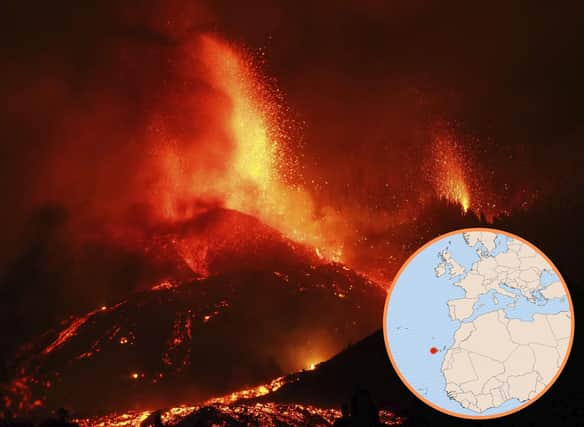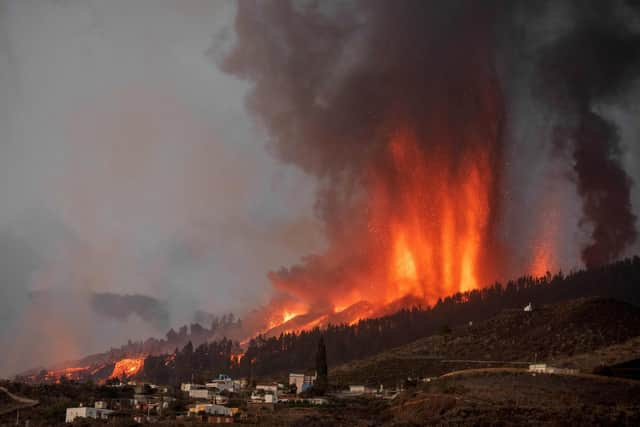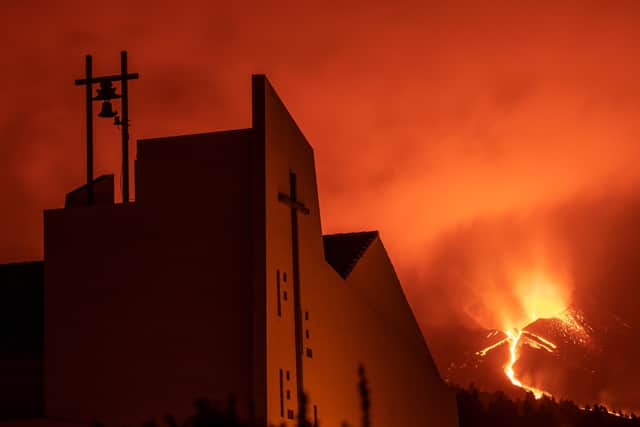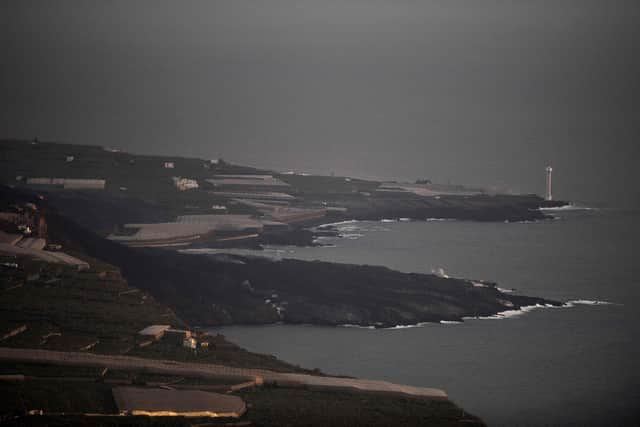La Palma volcano: Where is La Palma? Map shows where the Canary Islands volcano eruption is - and will it cause a tsunami?


A volcano located on the Canary Island of La Palma erupted on Sunday 19 September, sending lava streaming down hills and destroying hundreds of homes on the volcanic island.
5,000 people were initially evacuated from La Palma area surrounding the Cumbre Vieja volcano, but thousands more were forced to leave their homes following the eruption of a new vent on the Canary Islands volcanic ridge.
Advertisement
Hide AdAdvertisement
Hide AdThe volcano has now been erupting for around three weeks, with giant blocks of lava continuing to be spewed out of Cumbre Vieja as its flow of lava meets the ocean.
Here's what caused the Canary Islands volcanic eruption, where the volcano is located and how long the eruption could last.
Where is La Palma?
One of Spain’s seven Canary Islands, La Palma is the most northwesterly islands of the chain of volcanic islands like Tenerife, Fuerteventura, Gran Canaria and Lanzarote.
La Palma is the fifth largest of the islands, with an estimated area of 7,493km squared.


A popular tourist destination for snorkelling, and known for its rugged, rocky landscape, La Palma has a population of roughly 85,000 people.
The volcanic eruption on Sunday took place at the Cumbre Vieja volcano on the southwest of the Canary island.
What caused La Palma’s volcanic eruption?


The Canary Islands volcanic eruption took place following a swarm of earthquakes and tremors which have been rocking the island over the last two weeks.
A total of 642 quakes measuring between magnitude 2.0 and 3.0 were recorded on and around the island of La Palma during the last 14 days.
Advertisement
Hide AdAdvertisement
Hide AdThe dramatic eruption on Sunday 19 September is believed to have been triggered by a 4.2 magnitude earthquake striking the islands off Africa’s northwest coast.
Cumbre Vieja started to erupt at 3.15pm local time on Sunday after having last erupted in 1971.


Spanish Tourism Minister Reyes Maroto came under fire for comments calling the eruption a “wonderful show” and potential attraction for tourists.
How long could the La Palma volcano eruption last?
Volcanic eruptions can last between anywhere from days to months.
A volcano eruption at Iceland’s Mount Fagradalsfjall, to the southwest of Reykjavik, is the longest to occur in half a century.
Having begun on 16 March 2021, the Icelandic volcanic eruption will have lasted for six months as of Sunday 26 September.
The Canary Islands has historically seen plenty of volcanic activity, with an underwater submarine eruption occurring in waters off the island of El Hierro in 2011.


Could the La Palma volcano eruption cause a tsunami?
The Cumbre Vieja volcano is at risk of collapse should a volcanic eruption occur at the summit of the previously dormant volcanic ridge.
Advertisement
Hide AdAdvertisement
Hide AdIn the early 2000s, University College London scientists studied the volcano's destructive potential, finding that an eruption could trigger a dramatic landslide and consequent ‘mega tsunami’.
Scientists have also said that the risk of such a seismic shift and chances of triggering a tsunami rippling out across the Atlantic and potentially reaching the shores of the United States is small, however.
Dr Isobel Yeo, volcanologist at the UK’s National Oceanography Centre (NOC) said: “The eruptions have caused a great deal of local damage but the current level of seismic activity from magma rising and the eruptions is not something that we would expect to trigger a landslide and cause a mega tsunami in the future.
"Large-scale landslides and tsunami are very infrequent in the Canary Islands and their direct links to eruptions remain uncertain.
"However, the Canary Islands monitoring organisation, Involcan, will be keeping a close eye on the eruption and monitoring the events in the coming days.”
Dr Yeo added that theories of a potential collapse at Cumbre Vieja causing a landslide or ‘mega-tsunami’ would represent “an absolute worst-case scenario” and would be highly unlikely event during the current eruption.
“The "mega-tsunami" hypothesis needs a huge volume landslide,” Dr Yeo said.
“In my opinion, the current level of volcanism is not of sufficient magnitude to create the ground movement required to trigger such a landslide, nor is the type of slide required typical for this region.
Advertisement
Hide AdAdvertisement
Hide Ad“Although the current fountaining and lava flows have been destructive, there would likely have to be a substantial increase in explosivity or increase in the rate of lava expulsion that could spell a change in the dynamics on the island.
"While this is a possibility that we cannot rule out, it is very unlikely that a mega-tsunami will occur during the current unrest.”
A message from the Editor:
Thank you for reading this article. We're more reliant on your support than ever as the shift in consumer habits brought about by coronavirus impacts our advertisers.
If you haven't already, please consider supporting our trusted, fact-checked journalism by taking out a digital subscription.
Comments
Want to join the conversation? Please or to comment on this article.
